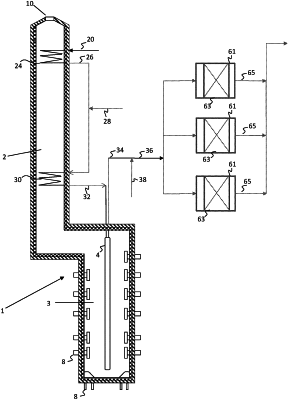| CPC C10G 57/00 (2013.01) [B01J 19/0006 (2013.01); B01J 19/0053 (2013.01); C07C 4/04 (2013.01); C07C 5/327 (2013.01); C10G 9/002 (2013.01); C10G 9/14 (2013.01); C10G 2300/1037 (2013.01); C10G 2300/807 (2013.01); C10G 2400/20 (2013.01)] | 18 Claims |

|
1. A process for producing olefins and/or dienes, the process comprising:
thermally cracking, within a reaction zone, a C2-C6 hydrocarbon-containing feed to produce a cracked hydrocarbon effluent containing methane and a mixture of C2-C6 olefins and paraffins, wherein a conversion of hydrocarbons in the C2-C6 hydrocarbon containing feed is in a range from about 10 mol % to 70 mol %;
receiving an entirety of the cracked hydrocarbon effluent and contacting the cracked hydrocarbon effluent with a second C2-C6 hydrocarbon-containing feed, comprising one or more C2-C6 hydrocarbons, thereby cooling the cracked hydrocarbon effluent via direct heat exchange with the second C2-C6 hydrocarbon-containing feed, producing a cooled cracked hydrocarbon effluent;
feeding an entirety of the cooled cracked hydrocarbon effluent to a dehydrogenation reaction zone, wherein there are no componential separators intermediate the reaction zone and the dehydrogenation reaction zone; and
dehydrogenating, within the dehydrogenation reaction zone, the cooled cracked hydrocarbon effluent to produce a dehydrogenated hydrocarbon effluent containing additional olefins and/or dienes.
|